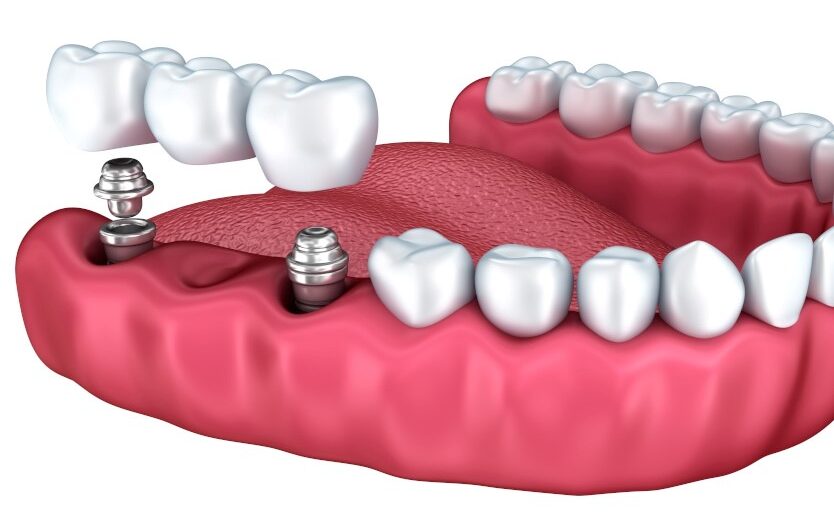
Dental implants, unlike other dental procedures, address the consequences of tooth loss both below and above the gum line. In an implant-based restoration, three pieces are usually involved: a dental implant that is directly implanted into the jaw, a restoration crown, and an abutment device that forms a connection between the implant and the restoration.
Dental implants are considered to be a long-term solution for replacing the missing tooth’s roots. Implants are prosthesis devices that allow people to have a strong bite and provide them with a more youthful appearance by preventing bone loss in the jaw and also providing a stable support base for various dental restorations.
These dental devices replace broken, extracted, and missing teeth and allow people to skip other dental alternatives like bridgework or dentures. However, the process of getting implants does not happen overnight. In this procedure, the placement of an implant is the most complicated part because it requires interaction with the gums and jawbone. If it is not set appropriately, the tooth will not stay in place and can result in problems for the rest of the patient’s mouth.
There are various dental implant stages that every patient has to go through, and it could require up to a year to complete. They include
- Pre-surgical appointments
- The surgery itself (three individual stages)
- Recovery and follow-up appointments
Who Can Be the Apt Candidate for Implants?
Anyone with one or two missing teeth can be a good candidate for getting dental implants if he is in good general and oral health. Moreover, it is best to have adequate jaw bone to support a dental implant, and candidates must have healthy gums that are free of periodontal disease. People who have the following habits can also opt for this dental procedure:
- Good oral hygiene regimen.
- Do not have the habit of smoking.
- Have patience with the process; which can take up to twelve months to be fully completed.
Stages for Getting Dental Implants
Dental Examination
Before the implantation process starts, the dentist thoroughly examines the patient’s oral health. In the examination process, dentists do not solely rely on two-dimensional X-rays and conduct 3D imaging employing a CT scan which helps them to better assess the patient’s dental health, especially the bone supporting the implant.
Removal of Tooth or Teeth
The next step in dental implantation is the removal of the tooth that will be replaced. This is usually performed by a specialized oral surgeon as it is a complicated process.
Bone Grafting
If the initial exam shows that patients do not have adequate bone to support the implant, the dentist might need to perform another process called a bone graft, where the bone is harvested from elsewhere in the patient’s body and is then placed where it is required.
Placing an Implant
The placement of the dental implant procedure begins by surgically positioning the screw into the patient’s jawbone. To place the titanium metal, the oral surgeon makes an incision through the gums, sets the implant, then closes this area with the help of sutures. After this, the patient is sent home to allow the healing of the gums. This can take up to six months or more, depending on how fast the patient recovers.
The dental implant should fuse with the patient’s natural bone in a process termed as Osseo integration. In this process, the bone cells attach to the screw and spaces to permanently fix the implant. Once this step is successful, then the dentist moves to the next phase of dental implantation.
Set the Abutment
After Osseo integration, the abutment is placed in the affected area. It is the connective post that links the artificial tooth and the implant. The abutment ensures that the implant remains in place under the gums. Like an implant, the abutment also needs to heal properly. The gums surrounding the abutment must heal and form a concoction around it before the dental restoration is placed.
Placement of Restoration
The last step of the implant procedure is to place the dental restorative option, which can be either a denture or a crown. However, after the dental implant procedure, crowns are the most recommended option because they look and function just like natural teeth and are relatively more durable than dentures. The dental implant procedure is finally completed after the crown is cemented to the abutment.
Advantages of Dental Implants
Implants have multiple benefits, including:
Prevents Bone Loss
When a person loses teeth, and bone mass in the jaw, the jawbone requires stimulation, and implants are the only tooth replacement alternative that replaces jawbone stimulation and helps to prevent bone loss.
Matches the Natural Teeth
Dental implants come in a vast range of sizes and shapes. The dentist designs implants that specifically match the color of the patient’s surrounding teeth and fit perfectly in the gap.
Restores Bite Force
Because dental implants are placed into the jaw with a titanium post or screw that replaces the tooth root, they can allow the patient to bite with the same amount of force he could use with the natural teeth. Other dental treatment options do not fully restore the bite force because they are usually placed over the visible part of the teeth and are not anchored deeply in place.
Prevents Changes in the Facial Structure
Teeth help support your facial structure. When people lose one or more teeth, they lose that support, which eventually causes their face to sag, change shape, and make them appear older. Dental implants provide the exact same support to the face as natural teeth and prevent facial sagging.
Risks
Common risks of dental implants usually include:
- Infection at the affected site.
- Injury or damage to surrounding oral structures, such as gums, other teeth or blood vessels.
- Nerve damage can lead to numbness, pain, or tingling in your natural teeth, gums, lips or chin.
- Sinus problems, usually occur when implants are placed in the upper jaw and protrude into one of the sinus cavities.






